
In the Utilities window that opens, scroll down and look for the Terminal icon.Click the Go menu, and then select Utilities.
#FORKLIFT 2 SHOW HIDDEN FILES MAC#
It gives you access to some of the most powerful commands to unpack the functioning of your Mac operating system. The command-line based Terminal window in Mac is the equivalent of the Command Prompt in Microsoft Windows. Note: To hide these files, simply press the shortcut keys once again.

Furthermore, you can search across various files, folders and organize them in a single place for your ease. The Finder provides you easy access to local folders on your Mac, along with the content stored on the iCloud Drive and any other removable storage devices such as a Backup Drive or a USB Stick. Hide & Unhide Hidden Files in Mac Method 1: Use the Finder In the latter half, we will look at how you can delete duplicate files to free-up precious storage space. In this article, we’ll learn various ways to hide as well as unhide the Hidden Files in a Mac.

Some of these files are stored in the ~/Library folder while others are scattered across different locations. Even though these files are hidden, they take a significant portion of the disk space. Just like any other operating system, some files are hidden in Mac from an ordinary user.


 0 kommentar(er)
0 kommentar(er)
